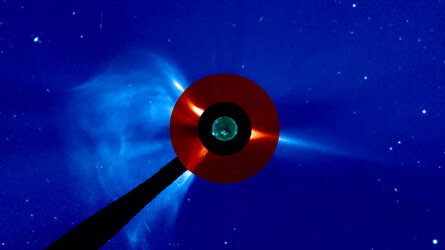Accept all cookies Accept only essential cookies See our Cookie Notice

About ESA
The European Space Agency (ESA) is Europe’s gateway to space. Its mission is to shape the development of Europe’s space capability and ensure that investment in space continues to deliver benefits to the citizens of Europe and the world.
Highlights
ESA - United space in Europe
This is ESA ESA facts Member States & Cooperating States Funding Director General Top management For Member State Delegations European vision European Space Policy ESA & EU Space Councils Responsibility & Sustainability Annual Report Calendar of meetings Corporate newsEstablishments & sites
ESA Headquarters ESA ESTEC ESA ESOC ESA ESRIN ESA EAC ESA ESAC Europe's Spaceport ESA ESEC ESA ECSAT Brussels Office Washington OfficeWorking with ESA
Business with ESA ESA Commercialisation Gateway Law at ESA Careers Cyber resilience at ESA IT at ESA Newsroom Partnerships Merchandising Licence Education Open Space Innovation Platform Integrity and Reporting Administrative Tribunal Health and SafetyMore about ESA
History ESA Historical Archives Exhibitions Publications Art & Culture ESA Merchandise Kids Diversity ESA Brand Centre ESA ChampionsLatest
Space in Member States
Find out more about space activities in our 23 Member States, and understand how ESA works together with their national agencies, institutions and organisations.
Science & Exploration
Exploring our Solar System and unlocking the secrets of the Universe
Go to topicAstronauts
Missions
Juice Euclid Webb Solar Orbiter BepiColombo Gaia ExoMars Cheops Exoplanet missions More missionsActivities
International Space Station Orion service module Gateway Concordia Caves & Pangaea BenefitsLatest
Space Safety
Protecting life and infrastructure on Earth and in orbit
Go to topicAsteroids
Asteroids and Planetary Defence Asteroid danger explained Flyeye telescope: asteroid detection Hera mission: asteroid deflection Near-Earth Object Coordination CentreSpace junk
About space debris Space debris by the numbers Space Environment Report In space refuelling, refurbishing and removingSafety from space
Clean Space ecodesign Zero Debris Technologies Space for Earth Supporting Sustainable DevelopmentApplications
Using space to benefit citizens and meet future challenges on Earth
Go to topicObserving the Earth
Observing the Earth Future EO Copernicus Meteorology Space for our climate Satellite missionsCommercialisation
ESA Commercialisation Gateway Open Space Innovation Platform Business Incubation ESA Space SolutionsLatest
Enabling & Support
Making space accessible and developing the technologies for the future
Go to topicBuilding missions
Space Engineering and Technology Test centre Laboratories Concurrent Design Facility Preparing for the future Shaping the Future Discovery and Preparation Advanced Concepts TeamSpace transportation
Space Transportation Ariane Vega Space Rider Future space transportation Boost! Europe's Spaceport Launches from Europe's Spaceport from 2012Latest

An orbit’s worth of particle data
Thank you for liking
You have already liked this page, you can only like it once!
Solar Orbiter’s Energetic Particle Detector (EPD) has been switched on and collecting data since March 2020. It has now collected an entire orbit's worth of data.
EPD measures the energetic particles that zip past the spacecraft. It looks at their composition and variation in time. The data will help scientists investigate the sources, acceleration mechanisms, and transport processes of these particles.
The diagram shows the flux of particles captured by the spacecraft during its first orbit (the earliest data is not included to avoid overlap on this diagram). The flux is calculated from the rate at which energetic particles are entering the instrument and represents space weather events in the solar wind. The spikes indicate the fluxes of electrons (shown as spikes pointing inwards towards the Sun in this representation) and ions (spikes pointing outwards), on a logarithmic scale.
The solar wind is the constant stream of particles that flows away from the Sun. Energetic events such as solar flares and coronal mass ejections can accelerate and release large quantities of high-energy particles. Although the Sun has been relatively inactive this year, there have still been a number of space weather events that had dramatically increased the number of energetic particles flowing past Solar Orbiter.
Although this plot comes from EPD, the three other in-situ instruments on Solar Orbiter are also designed to study these events in unprecedented detail. The three other instruments are Magnetometer (MAG), Radio and Plasma Waves (RPW), and Solar Wind Plasma Analyser (SWA).
By taking these state-of-the-art instruments close to the Sun, Solar Orbiter is able to use high data rates to capture the details with more fidelity than ever before. In the case of the EPD, researchers are already seeing rapid variations in the number of particles that are associated with changes in the magnetic field, as seen by MAG.
This is revealing fine scale structures and new physical interactions in the solar wind that we have never seen before.
-
CREDIT
Solar Orbiter/EPD/ESA & NASA; CAU Kiel; J. von Forstner, A. Kollhoff -
LICENCE
ESA Standard Licence

Detecting a solar energetic particle event with Sola…

Solar Orbiter first images and measurements

EUI’s first coronal mass ejection

Joining the dots of an energetic particle event















 Germany
Germany
 Austria
Austria
 Belgium
Belgium
 Denmark
Denmark
 Spain
Spain
 Estonia
Estonia
 Finland
Finland
 France
France
 Greece
Greece
 Hungary
Hungary
 Ireland
Ireland
 Italy
Italy
 Luxembourg
Luxembourg
 Norway
Norway
 The Netherlands
The Netherlands
 Poland
Poland
 Portugal
Portugal
 Czechia
Czechia
 Romania
Romania
 United Kingdom
United Kingdom
 Slovenia
Slovenia
 Sweden
Sweden
 Switzerland
Switzerland
























